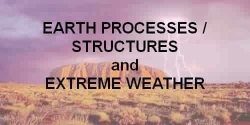Flood Hazard Categories
Flood Hazard Categories - Case Study - Johnstone River Flooding
Choosing Flood Hazard
Categories
Recommended Approach
Flood Hazard Definitions
Local Area Hazard Map
Flood Warning and Emergency
Planning
Categories Choosing Flood Hazard
It is necessary to divide the floodplain into flood hazard categories that reflect the flood behaviour across the floodplain. CSIRO (2000) refers to the degree of flood hazard as being a function of:
- the size (magnitude) of flooding;
- depth and velocity (speed of flowing water);
- rate of floodwater rise;
- duration of flooding;
- evacuation problems;
- effective flood access;
- size of population at risk;
- land use;
- flood awareness/readiness;
- effective flood warning time.
The categorisation of the floodplain is largely qualitative using the above factors. For example, medium hazard is where adults could wade safely, but children and elderly may have difficulty, evacuation is possible by a sedan, there is ample time for flood warning and evacuation and evacuation routes remain trafficable for at least twice as long for the required evacuation time.
A key factor in the ease of evacuation from an area is the water depth and the velocity along the evacuation route, ie, the stability of pedestrians wading through flood waters or vehicles driving along flooded roads. CSIRO (2000) notes that there are estimation procedures available for stability estimation, but considers that further research is required across a broader range of conditions and so does not recommend a procedure for hazard categorisation on this basis.
Recommended Approach
In considering the application of these issues to the specific flood characteristics of the lower Johnstone River floodplain, it is noted that:- duration of flooding is universally long (in the order of days) across the floodplain;
- warning times can be short (~6 hrs);
- rates of floodwater rise are reasonably fast; and
- flood awareness is generally high and does not vary significantly across the floodplain.
The above four parameters are not significantly variable across the floodplain to warrant specific
treatment and are therefore not used to define variations in the flood hazard, but should be included in
development control measures. The flood hazard is therefore defined on the remaining, varying
characteristics of:
- the size of the flood;
- depth and velocity of floodwaters; and
- evacuation and access.
Flood Hazard Definitions
Local Area Hazard Map
Planning Flood Warning and Emergency
In the Johnstone region, many people come from families that have resided in the area for several
generations. In most cases, these people have either experienced a flood or have heard first hand
accounts of floods from family members or friends. Therefore, they are likely to have a high level of
flood awareness. However, these people may not be aware that there may be larger floods than those
events that they have experienced or heard of. In addition, there are a significant number of new rural
and urban residents in the region who may not have the same level of flood awareness. In some
instances, these people:
- have not experienced a flood in the area;
- have not heard first hand accounts of previous floods;
- live in houses that are not near the river, but are actually in the floodplain and are subject to flooding; and/or
- are not likely to take flood warnings seriously.
Both groups of people, those who have a low level of flood awareness and those who may not believe
that there will be a larger flood than the biggest historical flood, that should be the target of a flood
information campaign.

